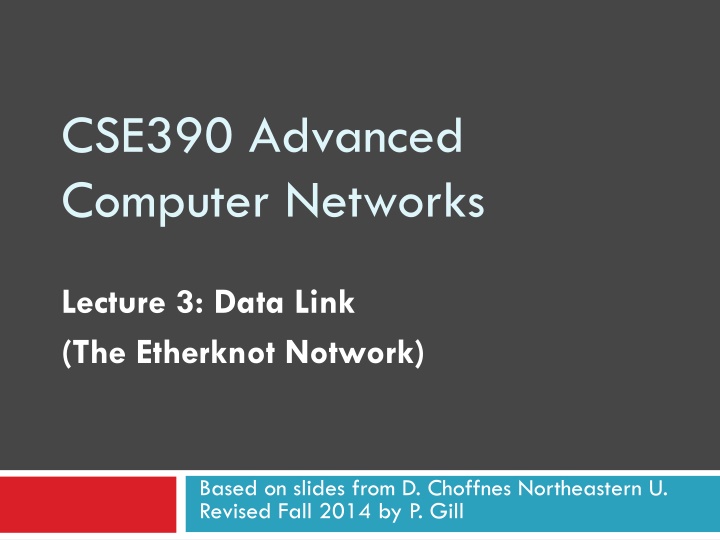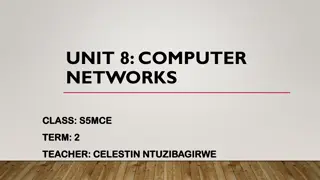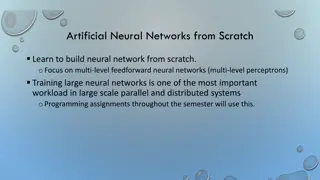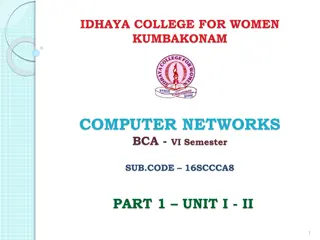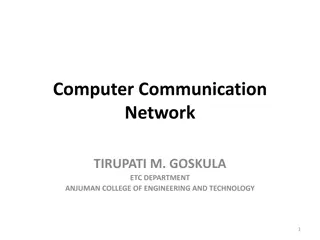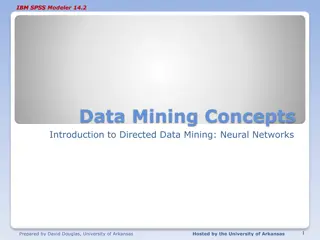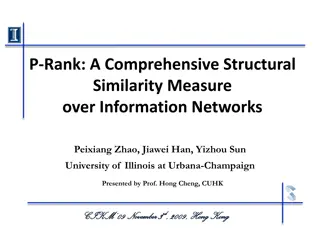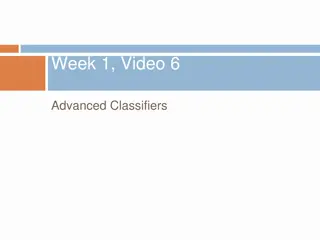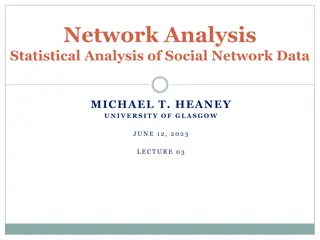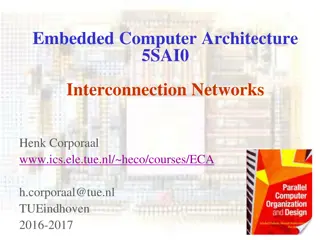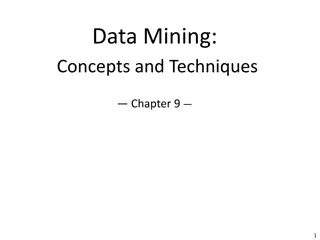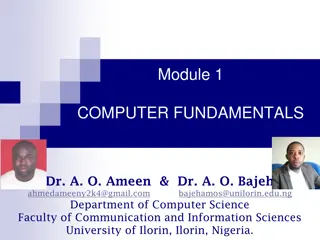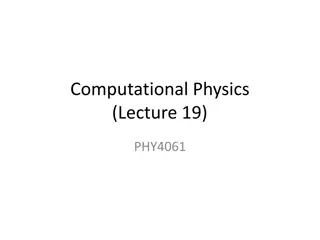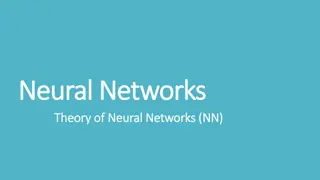CSE390 Advanced Computer Networks
Framing in the data link layer involves sending blocks of data between physical devices while regulating access to the physical media. Challenges include delineating frames, error detection, implementing media access control (MAC), and avoiding collisions. This process requires determining how bits are encoded and defining data boundaries for reading headers. Different framing types such as byte-oriented, bit-oriented, and clock-based protocols are used to ensure the reliable transmission of data.
Download Presentation

Please find below an Image/Link to download the presentation.
The content on the website is provided AS IS for your information and personal use only. It may not be sold, licensed, or shared on other websites without obtaining consent from the author.If you encounter any issues during the download, it is possible that the publisher has removed the file from their server.
You are allowed to download the files provided on this website for personal or commercial use, subject to the condition that they are used lawfully. All files are the property of their respective owners.
The content on the website is provided AS IS for your information and personal use only. It may not be sold, licensed, or shared on other websites without obtaining consent from the author.
E N D
Presentation Transcript
CSE390 Advanced Computer Networks Lecture 3: Data Link (The Etherknot Notwork) Based on slides from D. Choffnes Northeastern U. Revised Fall 2014 by P. Gill
Administrative notes 2 If you have not, PLEASE JOIN THE PIAZZA PAGE! Link can be found on the course Web page: www.cs.stonybrook.edu/~cse390 Important announcements are posted there! E.g., discussion leads Assignment 1 is posted on the course Web page. Submission details coming soon. Deadline is September 10
Administrative notes: Discussion leads 3 Tentative schedule for next couple of weeks Email me if you cannot lead on your assigned day Remember to post responses for at least 12 papers. 20% participation mark depends on this! Today: Elton (P85) Lecture 5 (Sept 10) Luis - SG04 & Scott - TLS+10 Lecture 6 (Sept 17) Scott CR04 & James KSC+12 Lecture 8 (Sept 24) Michael -- CK74 & Yubo -- Jac88
Data Link Layer 4 Function: Send blocks of data (frames) between physical devices Regulate access to the physical media Key challenge: How to delineate frames? How to detect errors? How to perform media access control (MAC)? How to recover from and avoid collisions? Application Presentation Session Transport Network Data Link Physical
Outline 5 Framing Error Checking and Reliability Media Access Control 802.3 Ethernet 802.11 Wifi
Framing 6 Physical layer determines how bits are encoded Next step, how to encode blocks of data Packet switched networks Each packet includes routing information Data boundaries must be known so headers can be read Types of framing Byte oriented protocols Bit oriented protocols Clock based protocols
Byte Oriented: Sentinel Approach 7 START DLE DLE Data DLE END END Add START and END sentinels to the data Problem: what if END appears in the data? Add a special DLE (Data Link Escape) character before END What if DLE appears in the data? Add DLE before it. Similar to escape sequences in C printf( You must \ escape\ quotes in strings ); printf( You must \\escape\\ forward slashes as well ); Used by Point-to-Point protocol, e.g. modem, DSL, cellular
Byte Oriented: Byte Counting 8 132 132 Data Sender: insert length of the data in bytes at the beginning of each frame Receiver: extract the length and read that many bytes What happens if there is an error transmitting the count field?
Bit Oriented: Bit Stuffing 9 01111110 Data 01111110 Add sentinels to the start and end of data Both sentinels are the same Example: 01111110 in High-level Data Link Protocol (HDLC) Sender: insert a 0 after each 11111 in data Known as bit stuffing Receiver: after seeing 11111 in the data 111110 remove the 0 (it was stuffed) 111111 look at one more bit 1111110 end of frame 1111111 error! Discard the frame Disadvantage: 20% overhead at worst What happens if error in sentinel transmission?
Clock-based Framing: SONET 10 Synchronous Optical Network Transmission over very fast optical links STS-n, e.g. STS-1: 51.84 Mbps, STS-768: 36.7 Gbps STS-1 frames based on fixed sized frames 9*90 = 810 bytes after 810 bytes look for start pattern 90 Columns Physical layer details Bits are encoded using NRZ Payload is XORed with a special 127-bit pattern to avoid long sequences of 0 and 1 Special start pattern Overhead 9 Rows Payload
Outline 11 Framing Error Checking and Reliability Media Access Control 802.3 Ethernet 802.11 Wifi
Dealing with Noise 12 The physical world is inherently noisy Interference from electrical cables Cross-talk from radio transmissions, microwave ovens Solar storms How to detect bit-errors in transmissions? How to recover from errors?
Nave Error Detection 13 Idea: send two copies of each frame if (memcmp(frame1, frame2) != 0) { OH NOES, AN ERROR! } Why is this a bad idea? Extremely high overhead Poor protection against errors Twice the data means twice the chance for bit errors
Parity Bits 14 Idea: add extra bits to keep the number of 1s even Example: 7-bit ASCII characters + 1 parity bit 0101001 1 1 10 1101001 0 1011110 1 0001110 1 0110100 1 Detects 1-bit errors and some 2-bit errors Not reliable against bursty errors
Two Dimensional Parity 15 Parity bit for each row 0101001 1101001 1011110 0001110 0110100 1011111 1111011 0 1 0 1 1 1 0 Parity bit for each column Parity bit for the parity byte Can detect all 1-, 2-, and 3-bit errors, some 4-bit errors 14% overhead
Two Dimensional Parity Examples 16 0101001 1101001 1011110 0001110 0110100 1011111 1111011 0 1 0 1 1 1 0 Odd number of 1s 1 0 Odd number of 1s 1 1 Odd number of 1s Odd Number of 1s
Checksums 17 Idea: Add up the bytes in the data Include the sum in the frame START Data Checksum END Use ones-complement arithmetic Lower overhead than parity: 16 bits per frame But, not resilient to errors Why? 0101001 1 1101001= 10010010 + 0 Used in UDP, TCP, and IP
Cyclic Redundancy Check (CRC) 18 Uses field theory to compute a semi-unique value for a given message Much better performance than previous approaches Fixed size overhead per frame (usually 32-bits) Quick to implement in hardware Only 1 in 232 chance of missing an error with 32-bit CRC Details are in the book/on Wikipedia
What About Reliability? 19 How does a sender know that a frame was received? What if it has errors? What if it never arrives at all? Sender Receiver Time Acknowledgement
Stop and Wait 20 Simplest form of reliability Sender Receiver Example: Bluetooth Problems? Utilization Can only have one frame in flight at any time Timeout 10Gbps link and 10ms delay Assume packets are 1500B 1500B*8bit/(2*10ms) = 600Kbps Utilization is 0.006% Timeout
Sliding Window 21 Allow multiple outstanding, un-ACKed frames Number of un-ACKed frames is called the window Sender Receiver Window Made famous by TCP We ll look at this in more detail later
Should We Error Check in the Data Link? 22 Recall the End-to-End Argument Cons: Error free transmission cannot be guaranteed Not all applications want this functionality Error checking adds CPU and packet size overhead Error recovery requires buffering Pros: Potentially better performance than app-level error checking Data link error checking in practice Most useful over lossy links Wifi, cellular, satellite
Outline 23 Framing Error Checking and Reliability Media Access Control 802.3 Ethernet 802.11 Wifi
What is Media Access? 24 Ethernet and Wifi are both multi-access technologies Broadcast medium, shared by many hosts Simultaneous transmissions cause collisions This destroys the data Media Access Control (MAC) protocols are required Rules on how to share the medium Strategies for detecting, avoiding, and recovering from collisions
Strategies for Media Access 25 Channel partitioning Divide the resource into small pieces Allocate each piece to one host Example: Time Division Multi-Access (TDMA) cellular Example: Frequency Division Multi-Access (FDMA) cellular Taking turns Tightly coordinate shared access to avoid collisions Example: Token ring networks Contention Allow collisions, but use strategies to recover Examples: Ethernet, Wifi
Contention MAC Goals 26 Share the medium Two hosts sending at the same time collide, thus causing interference If no host sends, channel is idle Thus, want one user sending at any given time High utilization TDMA is low utilization Just like a circuit switched network Simple, distributed algorithm Multiple hosts that cannot directly coordinate No fancy (complicated) token-passing schemes
Contention Protocol Evolution 27 ALOHA Developed in the 70 s for packet radio networks If you receive a transmission from another station while transmitting there has been a collision, retransmit later Slotted ALOHA Start transmissions only at fixed time slots Significantly fewer collisions than ALOHA Carrier Sense Multiple Access (CSMA) Start transmission only if the channel is idle CSMA / Collision Detection (CSMA/CD) Stop ongoing transmission if collision is detected
ALOHA 28 Topology: radio broadcast with multiple stations Protocol: Stations transmit data immediately Receivers ACK all packets No ACK = collision, wait a random time then retransmit Simple, but radical concept Previous attempts all divided the channel TDMA, FDMA, etc. Optimized for the common case: few senders A B C
Tradeoffs vs. TDMA 29 In TDMA, each host must wait for its turn Delay is proportional to number of hosts In Aloha, each host sends immediately Much lower delay But, much lower utilization Throughput 2*Frame_Width ALOHA Frame Sender A ALOHA Frame Sender B Time Maximum throughput is ~18% of channel capacity Load
Slotted ALOHA 30 Protocol Same as ALOHA, except time is divided into slots Hosts may only transmit at the beginning of a slot Thus, frames either collide completely, or not at all 37% throughput vs. 18% for ALOHA But, hosts must have synchronized clocks Throughput Load
802.3 Ethernet 31 7 1 0-46 Bytes 6 6 2 0-1500 4 Preamble SF Source Dest. Length Data Pad Checksum Preamble is 7 bytes of 10101010. Why? Start Frame (SF) is 10101011 Source and destination are MAC addresses E.g. 00:45:A5:F3:25:0C Broadcast: FF:FF:FF:FF:FF:FF Minimum packet length of 64 bytes, hence the pad
Broadcast Ethernet 32 Originally, Ethernet was a broadcast technology 10Base2 Terminator Repeater Tee Connector Hubs and repeaters are layer-1 devices, i.e. physical only 10BaseT and 100BaseT T stands for Twisted Pair Hub
CSMA/CD 33 Carrier sense multiple access with collision detection Key insight: wired protocol allows us to sense the medium Algorithm Sense for carrier If carrier is present, wait for it to end Sending would cause a collision and waste time Send a frame and sense for collision If no collision, then frame has been delivered If collision, abort immediately Why keep sending if the frame is already corrupted? Perform exponential backoff then retransmit 1. 2. 3. 4. 5. 6.
CSMA/CD Collisions 34 Spatial Layout of Hosts Collisions can occur Collisions are quickly detected and aborted A B C D Note the role of distance, propagation delay, and frame length t0 t1 Time Detect Collision and Abort
Exponential Backoff 35 When a sender detects a collision, send jam signal Make sure all hosts are aware of collision Jam signal is 32 bits long (plus header overhead) Exponential backoff operates in multiples of 512 bits Select k [0, 2n 1], where n = number of collisions Wait k * 51.2 s before retransmission n is capped at 10, frame dropped after 16 collisions Backoff time is divided into contention slots Remember this number
Minimum Packet Sizes 36 Why is the minimum packet size 64 bytes? To give hosts enough time to detect collisions What is the relationship between packet size and cable length? A B 1. Time t: Host A starts transmitting 2. Time t + d: Host B starts transmitting 3. Time t + 2*d: collision detected Basic idea: Host A must be transmitting at time 2*d! Propagation Delay (d)
Minimum Packet Size 37 Host A must be transmitting after 2*d time units Min_pkt = bw (b/s) * 2 * d (s) but what is d? propagation delay: limited by speed of light Propagation delay (d) = distance (m) / speed of light (m/s) This gives: Min_pkt = bw (b/s) * 2 * dist (m) / speed of light (m/s) faster Ethernet standards 10 Mbps Ethernet Packet and cable lengths change for So cable length is equal . Dist = min_pkt * light speed /(2 * bw) (64B*8)*(2.5*108mps)/(2*107bps) = 6400 meters
Cable Length Examples 38 min_frame_size*light_speed/(2*bandwidth) = max_cable_length (64B*8)*(2.5*108mps)/(2*10Mbps) = 6400 meters What is the max cable length if min packet size were changed to 1024 bytes? 102.4 kilometers What is max cable length if bandwidth were changed to 1 Gbps ? 64 meters What if you changed min packet size to 1024 bytes and bandwidth to 1 Gbps? 1024 meters
Exponential Backoff, Revisited 39 Remember the 512 bit backoff timer? Minimum Ethernet packet size is also 512 bits 64 bytes * 8 = 512 bits Coincidence? Of course not. If the backoff time was <512 bits, a sender who waits and another who sends immediately can still collide
Maximum Packet Size 40 Maximum Transmission Unit (MTU): 1500 bytes Pros: Bit errors in long packets incur significant recovery penalty Cons: More bytes wasted on header information Higher per packet processing overhead Datacenters shifting towards Jumbo Frames 9000 bytes per packet
Long Live Ethernet 41 Today s Ethernet is switched More on this later 1Gbit and 10Gbit Ethernet now common 100Gbit on the way Uses same old packet header Full duplex (send and receive at the same time) Auto negotiating (backwards compatibility) Can also carry power
Outline 42 Framing Error Checking and Reliability Media Access Control 802.3 Ethernet 802.11 Wifi
802.3 vs. Wireless 43 Ethernet has one shared collision domain All hosts on a LAN can observe all transmissions Wireless radios have small range compared to overall system Collisions are local Collision are at the receiver, not the sender Carrier sense (CS in CSMA) plays a different role 802.11 uses CSMA/CA not CSMA/CD Collision avoidance, rather than collision detection
Hidden Terminal Problem 44 Radios on the same network cannot always hear each other Collision! A B C C cannot hear A A cannot hear C Hidden terminals mean that sender-side collision detection is useless
Exposed Terminal Problem 45 Carrier sense detects a busy channel Carrier sensing is problematic in wireless No collision No collision A B C D Carrier sense can erroneously reduce utilization
Reachability in Wireless 46 High level problem: Reachability in wireless is not transitive Just because A can reach B, and B can reach C, doesn t mean A can reach C A B C D
MACA 47 Multiple Access with Collision Avoidance Developed in 1990 Sense the channel The receiver is busy idle Channel is Host in Sender s Range Host in Receiver s Range Sender Receiver Soft-reserve the channel RTS but no CTS = clear to send transmission Successful
Collisions in MACA 48 What if sender does not receive CTS or ACK? Assume collision Enter exponential backoff mode
802.11b 49 802.11 Uses CSMA/CA, not MACA 802.11b Introduced in 1999 Uses the unlicensed 2.4 Ghz band Same band as cordless phones, microwave ovens Complementary code keying (CCK) modulation scheme 5.5 and 11 Mbps data rates Practical throughput with TCP is only 5.9 Mbps 11 channels (in the US). Only 1, 6, and 11 are orthogonal
802.11a/g 50 802.11a Uses the 5 Ghz band 6, 9, 12, 18, 24, 36, 48, 54 Mbps Switches from CCK to Orthogonal Frequency Division Multiplexing (OFDM) Each frequency is orthogonal 802.11g Introduced in 2003 Uses OFDM to improve performance (54 Mbps) Backwards compatible with 802.11b Warning: b devices cause g networks to fall back to CCK
